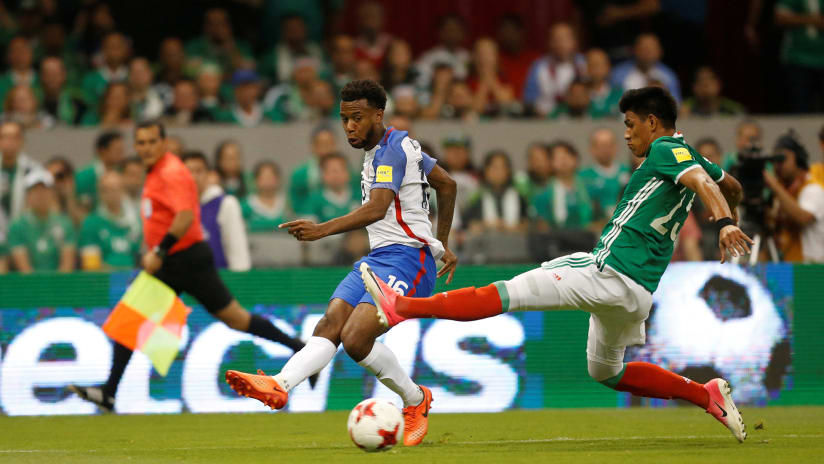It’s hosted two World Cup finals, and no venue on earth has staged more World Cup matches (19). It’s provided an iconic stage for the exploits of Pele, Maradona and even the Pope, holding crowds of well over 100,000 spectators. It sits some 7,516 feet above sea level in some of North America’s most polluted atmosphere, leaving visiting teams gasping for air like mountain climbers. And the Mexican national team almost never loses a World Cup qualifier there.
This is Estadio Azteca, the colossal stadium that will host Thursday’s Concacaf Octagonal clash between El Tri and the US men’s national team (10 pm ET | Paramount+, Univision, TUDN, CBS Sports Network). The US have never won a qualifier at the Mexico City landmark in 16 visits, with three draws and 13 losses all-time, and can point to just one victory, in a 2012 friendly.
While Mexico and the USMNT are tied in second place (separated by goal differential) – behind Ocho leaders Canada and must hold serve to fend off Panama and Costa Rica for the final two automatic qualification slots to Qatar – the Yanks don’t have to take points from this trip. It’s far more crucial to win next Sunday’s home date with Panama in Orlando, which also affects the approach taken by Gregg Berhalter and his staff – at least, you’d think.
Speaking to media after his roster unveiling Thursday night, the coach claimed that at least some of his 27-player squad would be able to go the distance in all three matches in this international window, which concludes with another daunting away day, at Costa Rica on March 30.
“It’s certainly possible. I wouldn't rule out a player being able to play 90 minutes at Azteca and 90 minutes in Orlando and 90 minutes again in San Jose,” Berhalter said. “When you look at some of our players, the rhythm that they're playing is basically Saturday, Wednesday, Saturday, Wednesday through most of the year.
“So some of our players, not all of them, but some of them are prepared and some of them will be able to play three 90-minute games. And it's just identifying who, and then rotating other ones out that aren’t able to play that amount,” he added, later suggesting that limited club minutes will keep Tim Weah from being one of said players, while Tyler Adams will have to put “mind over matter” and continue to be an ironman for the US despite his similar situation at RB Leipzig.
This year’s Concacaf Champions League has provided further evidence of the Mexican capital’s daunting conditions. Cruz Azul thoroughly dominated CF Montréal in their quarterfinal first leg last week, before Pumas UNAM pulled off one of CCL’s biggest-ever comebacks on the New England Revolution on Wednesday across town at Estadio Olímpico Universitario.
Berhalter, who lived this fixture repeatedly during his own playing career, said he reached out to some of those MLSers, and believes that the baseline fitness levels of his regulars will help them manage the rigors.
“Regarding Mexico City, I think the important thing is first to look at the starting point of where these guys are coming from,” he said. “So if a guy is fully fit and playing every week and has 90 minutes under his belt for a considerable amount of weeks, he'll be fine. They'll be fatigued a little bit at altitude, but they'll be able to get through it.
“I've had personal experience there, getting feedback from other countries that have played there already, getting feedback from MLS teams that have played there already. It's something you can get through. And so our job is to put 11 players on the field that can win the game and that's what we're here for. We're here to win soccer games, and we're going to put guys in the field against Mexico, against Panama and against Costa Rica that we feel can win the game.”
Beyond that, Berhalter was notably reluctant, compared to his USMNT predecessors, to reveal even generic information about his program’s mitigation of the Mexican capital’s notorious challenges.
Jurgen Klinsmann built an entire window’s schedule around the Mexico away match during the 2014 cycle, setting up camp in the high altitude of Colorado and hosting Costa Rica at the Rapids’ Dick’s Sporting Goods Park – the wintry match that would famously become the “SnowClasico” – in order to acclimate for the subsequent transition to Azteca, where the Yanks dug out a 0-0 draw.
Bruce Arena took a similar tack four years later, playing Trinidad & Tobago at DSG Park before the Mexico City trip and using “altitude tents” on players’ beds to replicate the oxygen levels of 10,000 feet above sea level.
With a scheduling quirk imposing an unusually short turnaround, he went even further by secretly splitting his squad into two distinct lineups and formations for the two games, beating the Soca Warriors with an attack-minded 4-4-2 before bunkering in with a 5-4-1 that helped scratch out a 1-1 draw at Azteca.
The USMNT will fly in to Mexico City on Wednesday morning, arriving as late as possible to ease the physiological effects of elevation. The performance staff have been monitoring players’ blood composition. And Berhalter said he plans to use the maximum of five substitutions against El Tri.
Whatever else he might be planning, he’s not sharing it.
“Mexico City, there's little things you can do, but unless you're there at altitude, it's hard to make a huge dent in it,” Berhalter said. “But we've been checking the players’ blood and making sure they have the necessary things to compete at that altitude.”













